|
|
 |
 |
| What Is a Devotional Image? |
|
|
Within the Hindu religious universe there is no single type of image or entity that is seen as enlivened by God. Some devotional images are natural features of the environment, spontaneous manifestations of God within the visible world that surrounds us; others are made by human hands and enlivened through ritual intervention. Some mimic human form but with significant elaboration and divine attributes, such as the multiple arms or blue skin with which the God Vishnu is commonly portrayed. Some images are meant for continual and permanent use; others are used only at particular festival times, for processions or other rituals (Figure 1), or are ephemeral, designed to be washed away or to fade with time. All relate to an ongoing process of embodiment and divinization -- the dynamic, multidimensional process by which the divine and the human worlds come together in a shared space.
Natural images take a variety of forms, some as simple as a mountain, river, or tree (Figure 2). The Himalayas, the abode of Shiva, are personified as the father of Parvati, whose name is derived from the word for mountain, parvat. Sacred rivers are personified as Goddesses, and are often portrayed on temple exteriors in human form as beautiful women. The Ganga (or Ganges) is one such natural image. Worship (puja) to this river, as to many other rivers, takes place at sunrise through the ritual bath and worship of the rising sun (Figure 3). The confluence of the Yamuna and the Ganga at the Sangam ("joining") at Allahabad is a particularly sacred place, as are the headwaters of the rivers in the foothills of the sacred Himalayas. The place where the Ganga reaches the plains, at Hardwar, is a renowned pilgrimage site designed for large-scale pilgrimage on sacred occasions. The temple complex at Jawalamukhi, in Himachal Pradesh, is centered around what is said to be a natural flame, representing the tongue of Sati, a form of the Goddess and wife of Shiva.
There is some overlap between natural and human-made images: a shiva linga, the non-anthropomorphic form of the great God Shiva, can be either (Figure 4). Naturally occurring images are known as "self-" or "independently-originating" (swayambhu). Human-made images of any type require ritual intervention to enliven them with divine presence. The power or presence of the God or Goddess enters through initiation, either at the beginning of worship or at the beginning of use of a new image. Human-made images can be made in human or anthropomorphic form, or, like the shiva linga, take a non-anthropomorphic (aniconic) form. There is not always a clear distinction between these types of images: eyes are often placed on non-anthropomorphic images to enliven them and facilitate visual exchange with the devotee. Some images simply evoke the anthropomorphic image of God, such as the feet of Vishnu that are central to the twice-yearly Vithoba festival held to honor a form of Krishna at Pandharpur in Maharashtra.
Most of the images found in the central shrines of temples are permanent and are never removed from the shrine once they are installed; other images are never intended for permanent installation. Popular ephemeral religious images are common within the urban centers of India, and hundreds are created for community-wide celebrations such as the Durga and Kali Pujas of Bengal, which provide a booming business for local image-makers. The Durga Puja festival takes place in September or October, and commemorates the return of the Goddess to her ancestral home in Bengal from her married home in the Himalayas, where she lives with her husband Shiva. Durga Puja images are constructed of unfired clay and depict the Goddess on her lion, killing the great buffalo demon Mahishasura; they are brought out in procession at the beginning and end of the festival (Figure 5), and on the ninth and final day are immersed in the river and washed away -- and the Goddess returns to her husband's far-off home (Figure 6). Similar unfired clay images are used in many different types of large-scale rituals as well as in small, home-based ones. Designs that decorate the home and workplace are another type of ephemeral sacred image, protecting the home and honoring the deity who protects it.
These are all forms of icons, embodiments of divinity. Humans can also embody divinity, and thus share with the sacred image a direct relationship with God. This takes place as a matter of course in many rituals in which the devotee identifies him- or herself with God, as well as with the image. It also occurs in other ways, such as possession and self-perfection through yogic and other practices. Through these means, oneness with God is achieved. In the case of possession, God occupies the devotee, with or without invitation, and acts and speaks through the possessed person, who becomes a vehicle for the deity. One among many terms for the deity in this form, according to the scholar of Goddess traditions Kathleen Erndl, is savari rup, "the form of a vehicle." Ascetics and renunciants are also worthy of worship and reverence, and viewing (darshan) of the holy person is a means of partaking in divinity.
The boundary between humanity and divinity is not fixed, as these examples make clear. Thus, in Ras-Lila performances, which depict the exploits of the boy-God Krishna and his consort Radha, the children portraying the deities are themselves thought of as the very forms (swarup) of the Gods. Reverence for human teachers, elders, and heroes is also common, partaking in the common vocabulary of reverence that shapes worship. Some hero-saints are divinized; an example of this is Guga-ji, a Rajasthani hero who is associated with cures for snakebite (and who, according to many versions of his story, converted to Islam late in life). Shrines that contain anthropomorphic depictions of Guga-ji on horseback are common across the northern plains, and singers who recount his exploits travel the countryside in August (Figure 7).
< previous next >
Top |
|
 |
 |
| Click for details |
 |
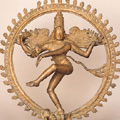 |
 |
Fig. 1
|
 |
 |
 |
Fig. 2
|
 |
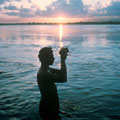 |
 |
Fig. 3
|
 |
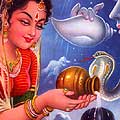 |
 |
Fig. 4
|
 |
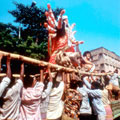 |
 |
Fig. 5
|
 |
 |
 |
Fig. 6
|
 |
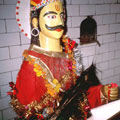 |
 |
Fig. 7
|
 |
|
 |


